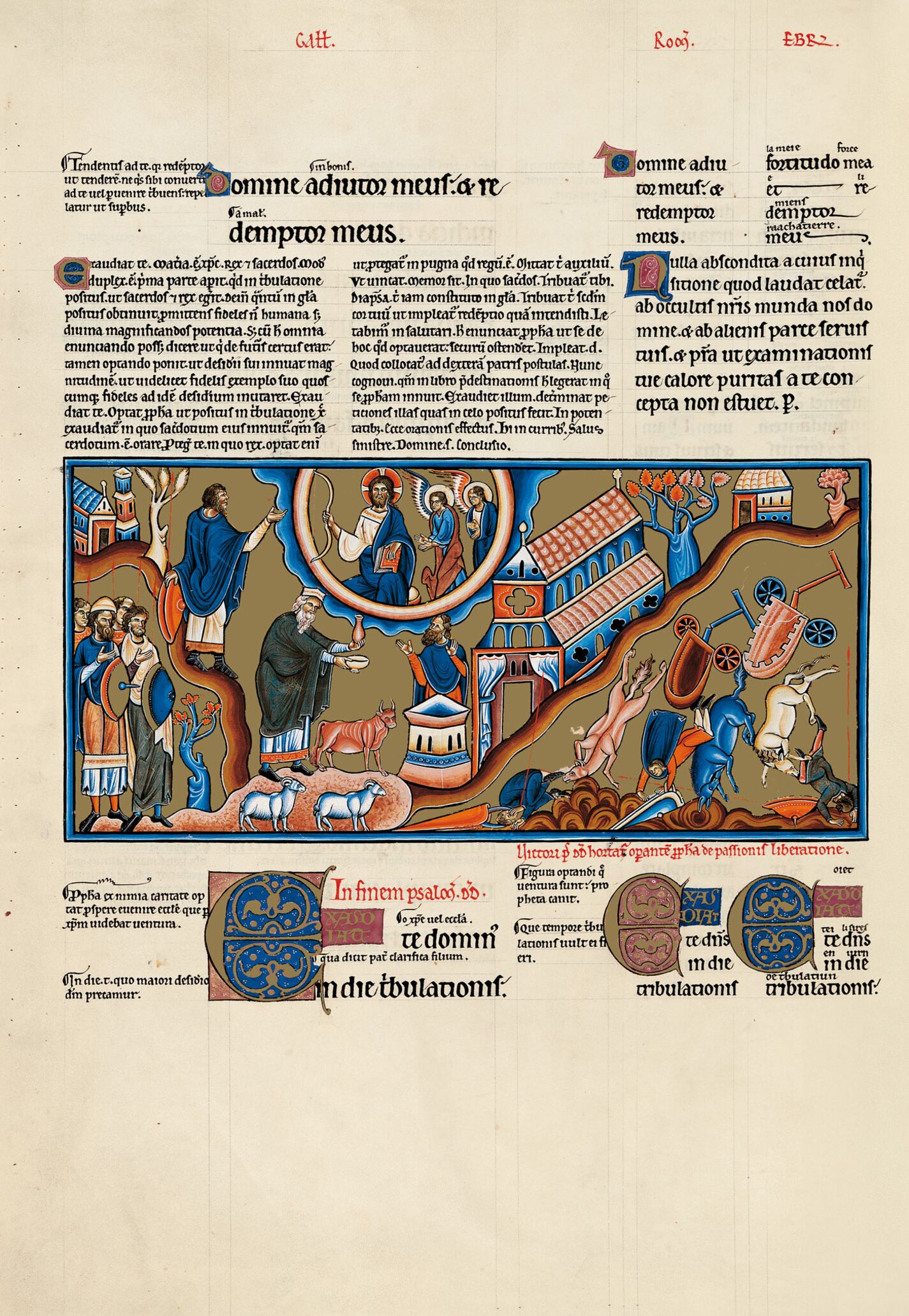The psalm expresses trust in God’s salvation. God, in a semicircle and accompanied by two angels, holds out in his right hand a bow to a man with shield and spear (v. 2, Exaudiat te Dominus in die tribulationis // May the Lord hear you in the day of tribulation; v. 7, Nunc cognovi quoniam salvum fecit Dominus christum suum. Exaudiat illum de celo sancto suo: in potentatibus salus dextere eius // Now have I known that the Lord has saved his anointed. He will hear from his holy heaven: the salvation of his right hand is in powers). At the bottom left, a group of men with shields and spears stands beside a tree. Below God, a king, accompanied by a bullock and two sheep for sacrifice, holds out a jug and bowl to a priest standing at an altar in front of a large church (v. 4, Memor sit omnis sacrificii tui, et holocaustum tuum pingue fiat // May he be mindful of all your sacrifices, and may the whole burnt offering be made fat). On the right, two broken chariots, armed soldiers and horses are falling headlong to the ground (v. 8, Hii(Si) in curribus, hii in equis // Some trust in chariots, and some in horses). There is a deliberate pictorial contrast between the falling of the men, horses and chariots on the right with the upright standing group of men on the left who proclaim the salvation of the king who offers sacrifice (v. 9, Ipsi obligati sunt et ceciderunt, nos vero surreximus et erecti sumus. Domine salvum fac regem, et exaudi nos in die qua invocaverimus te // They are bound and have fallen, but we are risen and set upright. O Lord, save the king and hears us when we call upon you). Similarly, the church where the sacrifice is offered for salvation is separated by the landscape contour of a hill from those who have fallen.

The psalm expresses trust in God’s salvation. God, in a semicircle and accompanied by two angels, holds out in his right hand a bow to a man with shield and spear (v. 2, Exaudiat te Dominus in die tribulationis // May the Lord hear you in the day of tribulation; v. 7, Nunc cognovi quoniam salvum fecit Dominus christum suum. Exaudiat illum de celo sancto suo: in potentatibus salus dextere eius // Now have I known that the Lord has saved his anointed. He will hear from his holy heaven: the salvation of his right hand is in powers). At the bottom left, a group of men with shields and spears stands beside a tree. Below God, a king, accompanied by a bullock and two sheep for sacrifice, holds out a jug and bowl to a priest standing at an altar in front of a large church (v. 4, Memor sit omnis sacrificii tui, et holocaustum tuum pingue fiat // May he be mindful of all your sacrifices, and may the whole burnt offering be made fat). On the right, two broken chariots, armed soldiers and horses are falling headlong to the ground (v. 8, Hii(Si) in curribus, hii in equis // Some trust in chariots, and some in horses). There is a deliberate pictorial contrast between the falling of the men, horses and chariots on the right with the upright standing group of men on the left who proclaim the salvation of the king who offers sacrifice (v. 9, Ipsi obligati sunt et ceciderunt, nos vero surreximus et erecti sumus. Domine salvum fac regem, et exaudi nos in die qua invocaverimus te // They are bound and have fallen, but we are risen and set upright. O Lord, save the king and hears us when we call upon you). Similarly, the church where the sacrifice is offered for salvation is separated by the landscape contour of a hill from those who have fallen.